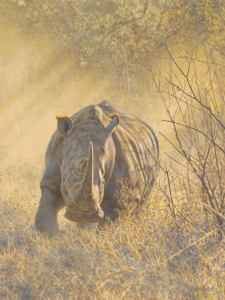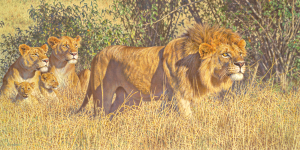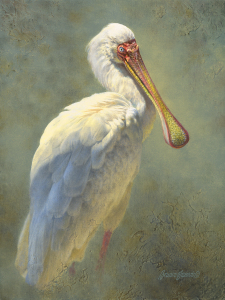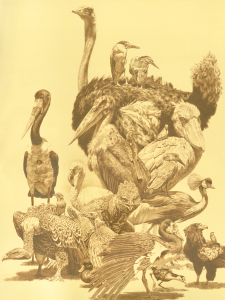 Imagine these pages of SAFARIMagazine without pictorial illustration or, more to the point, what if the current cover was blank? Art matters because it gives us a common focal point for reality and serves as a counterpoint to vacantness. It can compel us to rise out of our chairs, inspire us to make a positive difference in the world by getting involved with causes we believe in, and trigger important conversations about the future of the planet.
Imagine these pages of SAFARIMagazine without pictorial illustration or, more to the point, what if the current cover was blank? Art matters because it gives us a common focal point for reality and serves as a counterpoint to vacantness. It can compel us to rise out of our chairs, inspire us to make a positive difference in the world by getting involved with causes we believe in, and trigger important conversations about the future of the planet.
As you read these words, cover artist Brian Jarvi, a Minnesota painter widely praised for his portrayals of African wildlife, is embarking upon the most ambitious project of his career.
Rising off the ground in the form of seven interconnected panels stretching 27 feet across and anchored by a centerpiece painting nearly a story tall, Jarvi’s magnum opus, The Inquisition: An African Menagerie, just might be unprecedented in size, scale and scope as a work of wildlife art. The epic panoramic aims to stoke the conscience of sporting men and women, in addition to getting people excited about the experience of viewing great art.
 “Humankind quite literally is holding the natural world in its hands and the question before us now is, ‘Will we let some of the important pieces of it slip away?’” Jarvi asks from his studio in Grand Rapids, Minnesota. “I don’t need to remind hunters because we are the ultimate conservationists and we’re out there on the front lines. In Africa today, we’re in danger of losing numerous wild animal populations to poachers, habitat loss and indifference. Personally, I find that unacceptable and I hope my art can help spur action.”
“Humankind quite literally is holding the natural world in its hands and the question before us now is, ‘Will we let some of the important pieces of it slip away?’” Jarvi asks from his studio in Grand Rapids, Minnesota. “I don’t need to remind hunters because we are the ultimate conservationists and we’re out there on the front lines. In Africa today, we’re in danger of losing numerous wild animal populations to poachers, habitat loss and indifference. Personally, I find that unacceptable and I hope my art can help spur action.”
Jarvi’s been thinking about doing something big since the 1990s and now, in the prime of his career, believes he has maturity to pull it off. The seven half-life-size moveable murals will be painted primarily in oil on Belgian linen. He notes that the tradition of panel painting is age old, going back at least to ancient Greece, then embraced by the Romans and subsequently carried on throughout Christianity with artists commissioned to portray religious scenes in churches and cathedrals.
“I’ve always been fascinated by menageries, even as a young kid—both the presentation of them in historic fine art paintings and having my own collections of wild animals around,” Jarvi says. He believes that menageries speak to the human desire to have meaningful connections with nature.
 Jarvi says his intent is not to confront viewers with religious messages but rather to elevate the spiritual aspects of creation and the marvel of varying life forms that share the outdoors with humankind.
Jarvi says his intent is not to confront viewers with religious messages but rather to elevate the spiritual aspects of creation and the marvel of varying life forms that share the outdoors with humankind.
“The reason that I incorporated ‘inquisition’ into the title is to encourage reflection on our values as a 21st century society,” he says. “Sometimes, we’ve been forced as conservationists to adopt a species by species approach to saving things but there’s a vast range of creatures that benefit from having secure habitat.”
Upon its completion in a couple of years, Menagerie will feature more than 120 African wildlife species depicted in full color. The spectacle will range from large predators and prey to great apes such as gorillas and chimpanzees and include a diverse array of birds, amphibians and reptiles. Eventually, the artwork will tour museum venues as part of a traveling exhibition.
SCI members attending the annual conventions and stopping by Jarvi’s booth in 2015, 2016 and 2017 will be able to witness aspects of the project coming to life. “This is a true work in progress,” Jarvi says. “I can’t think of a better audience for me to offer sneak previews than members of this organization.”
Jarvi knows that Menagerie will seal his reputation as a painter. Already, his research pieces have won rave reviews. An avian piece in 2013 was juried into the prestigious Leigh Yawkey Woodson Art Museum’s annual Birds In Art show and it so impressed museum curators that it was purchased for the Woodson’s permanent collection.
“From just a first glance of Brian’s ‘African Spoonbill Prestudy,’ I knew its subtlety and mysterious quality would draw me back again and again,” says art historian and Woodson Director Kathy Foley. “That the Woodson Art Museum was able to acquire the painting for the collection was certainly an outcome I had hoped for.”
Jarvi’s spoonbill pre-study was actually the second artwork tied to Menagerie that he unveiled at the Woodson. In 2011, he also had a piece, “Bateleur Study,” juried into Birds in Art and three others juried into different museum shows. “Brian’s work has matured beautifully over the years that I have been privileged to view it,” Foley says. “There is a sensitivity and skillful handling of paint that I find especially appealing. He tends to leave some details to the viewer’s imagination, which is a good thing; it makes me think.”
Even if one isn’t a deep-pocketed collector who could afford to purchase Menagerie outright, there are opportunities for lovers of African wildlife art to have a connection to it nonetheless, Jarvi says. Along the way, he is completing more than 100 color studies, pre-studies and charcoal/graphite drawings being made available for sale. Those works, many of them similar to the pre-studies that debuted at the Woodson Art Museum, will be used as reference material.
Jarvi (b. 1956) made his first of many trips to Africa a quarter century ago. He visited Maasai Mara, Ngorongoro, Samburu and Amboseli wildlife preserves. He was left awestruck at each location but especially resonant was the scene of massive animal migrations occurring across the Serengeti. “It’s the last real deal of its kind in the world and even there, development pressure is pinching in,” Jarvi says. “Will it still exist in all its glory for our grandkids to see?”
Thematically, Jarvi says that compressing the huge assemblage of species into tight visual confines serves as a metaphor for the squeezing of the natural world occurring across much of Africa.
As a chronicler of nature, Jarvi identifies with the heralded 19th century landscape painters of the romantic era in North America who called attention to rapidly dwindling herds of bison and game species such as elk, moose, pronghorn and bighorn sheep. Jarvi is trying to do the same with Africa.
“What draws me to Brian’s artwork, besides his use of color and his great ability to portray the animal, is his understanding of the environment in which his subjects live. Things like that matter to me,” says art collector and SCI member Will Beecherl of Dallas. Beecherl bought a Jarvi elephant painting at SCI more than a dozen years ago and has added several pieces over the years.
 As part of the research for Menagerie, Jarvi is working on another huge pre-study titled “The Birds” that is vertically oriented and measures 36 X 48 inches. Showcasing his palette flair and attention to design and composition, the work glistens with an assemblage of recognizable and lesser-known species: ostrich; marabou, shoebill (whalehead) and saddle-billed storks, lesser flamingo, lilac breasted roller, emerald spotted wood dove, grey crowned crane, hooded and Rüppell’s vultures, red-and-yellow barbet, hammerkop, spur-winged goose, crowned eagle, secretarybird and black-crowned night heron, among others.
As part of the research for Menagerie, Jarvi is working on another huge pre-study titled “The Birds” that is vertically oriented and measures 36 X 48 inches. Showcasing his palette flair and attention to design and composition, the work glistens with an assemblage of recognizable and lesser-known species: ostrich; marabou, shoebill (whalehead) and saddle-billed storks, lesser flamingo, lilac breasted roller, emerald spotted wood dove, grey crowned crane, hooded and Rüppell’s vultures, red-and-yellow barbet, hammerkop, spur-winged goose, crowned eagle, secretarybird and black-crowned night heron, among others.
Todd Nelson, CEO of Kalahari Resorts, is a recent Jarvi collector and he is one of several investors helping to underwrite Menagerie. “We love to feature African artwork at our properties though I’ve struggled to find really good contemporary artists who are able to capture African animals. Brian captures the spirit and soul of lions and cats like nobody else,” Nelson says.
Not long ago, he bought an action-packed Jarvi predicament scene titled “Defense of the Realm.” It portrays a big male lion intensely moving out to confront unseen territorial intruders to protect members of his pride—two females and a pair of cubs—in the background.
The massive 36 X 72-inch piece prominently decorates the space behind the front desk at one of Kalahari’s new resorts. “It’s fabulous. It absolutely mesmerizes people,” Nelson says. “Brian is one of the great talents of his generation and, with Menagerie, I feel very fortunate to be involved with a project that is really going to solidify his place on the fine art map.”– Todd Wilkinson
